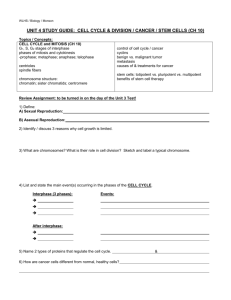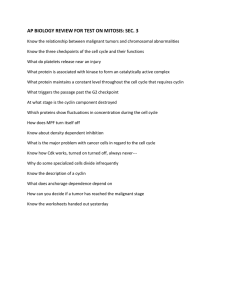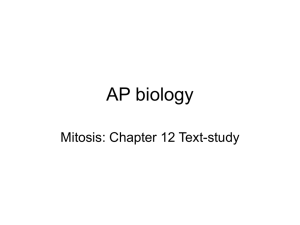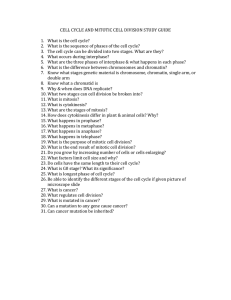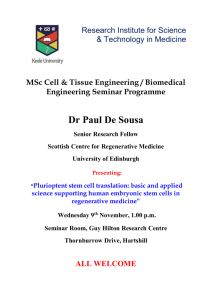The Cell Cycle
advertisement
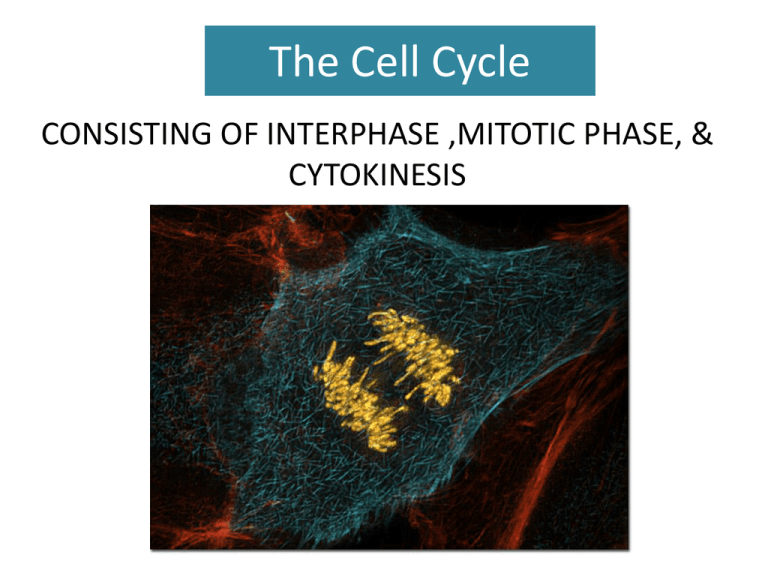
The Cell Cycle CONSISTING OF INTERPHASE ,MITOTIC PHASE, & CYTOKINESIS The Mitosis Puzzle Lay blank sheet lengthwise . Write Interphase, Prophase, Metaphase, Anaphase, & Telophase across the top of the sheet. Cut out the cell diagrams and tape/glue them across the top under the appropriate phase label. Arrange each description beneath the appropriate picture to describe the cellular changes of that phase. Why do cells divide? • Bacteria cells & unicellular eukaryotic organisms divide & produce an entire organism. • Multi-cellular organisms: – Development -Growth -Repair What do you get at the end of the cell cycle? 2 genetically identical daughter cells Cellular Organization PROKARYOTIC EUKARYOTIC Replication of so much DNA is manageable because of how DNA is packaged. chromatin chromosomes Does the number of chromosomes in an organism determine how complex the organism is? Organize the following organisms in order from complex to simple Bat Herring gull Human Crayfish Fern Reptiles Dog Parts of a chromosome THIS CHROMOSOME IS A DUPLICATED CHROMOSOME WITH 4 CHROMOSOMAL ARMS The Cell Cycle • Interphase – Accounts for 90% of the cycle – Divided up into 3 subunits The Cell Cycle • Mitotic phase – Includes both mitosis and cytokinesis – Usually the shortest part of the cell cycle. and Cytokinesis Mitotic Spindle • Begins to form during prophase & is complete during metaphase Form from the breakdown of microtubules of the cytoskeleton Not present in plant cells Starts here What is the significance of the fact that chromosomes condense before they are moved? WHICH OF THESE WOULD YOU RATHER ORGANIZE WITHOUT BREAKING? CYTOKINESIS ANIMAL CELLS PLANT CELLS BINARY FISSION PROKARYOTES (BACTERIA & ARCHEA) A protein is thought to anchor the DNA to specific spot on membrane Evolution of Mitosis Timing is everything! • The frequency of cell division varies with cell type. – EX: human skin cells vs liver cells • Some cells do not divide at all in a mature human. – EX: nerve cells and muscle cells What Drives The Cell Cycle? Hypothesis: -Each event in the cycle triggers the next. What was concluded? Molecules present in the cytoplasm of cells in the S or M phase control the progression of phases. CELL CYCLE CONTROL SYSTEM THE G1 CHECKPOINT The Cell Cycle Clock • Maturation/Mitosis Promoting Factor (MPF) are regulatory molecules (mainly proteins) –Protein kinases and cyclins plus a phosphate group Cyclin and Kinases •Kinases are enzymes •Activate or inactivate other proteins by phosphorylating them. •Give the go ahead signals at the G1 and G2 checkpoints. •Present in a constant concentration in a growing cell, but are mostly inactive. •To be active they must attach to a cyclin (a protein) = cyclin-dependent kinases, or Cdks Cyclin D triggers cells to move from G0 to G1 into S phase Cyclin E prepares the cell for DNA replication in S phase Cyclin A activates DNA replication inside the nucleus in S phase Cyclin B promotes the assembly of the mitotic spindle & other tasks in the cytoplasm to prepare for mitosis Cyclins and cyclin-dependent kinases control the cell cycle. After the MPF does its job the cyclin degrades. Why? The cell would continue to divide even when not ready In summary • Internally: – The fluctuation of cyclin & cyclin-dependent kinases seems to control the cell cycle internally using checkpoints to tell the cell to proceed or not – The MPF complexes (cyclin + Cdk) initiates mitosis & can then go on to produce a cascade of other cell responses including phosphorylation of other proteins which: • Promotes fragmentation of nuclear envelope • Chromosome condensation and spindle formation What about external factors? Example of a growth factor is PDGF (plateletderived growth factor) PDGF is required for the division of fibroblasts (a type of connective tissue) Triggers a transduction pathway allowing the cells to pass the G1 checkpoint & divide. An injury can instigate this growth factor to help heal a wound. MORE EXTERNAL FACTORS ON CELL DIVISION: DENSITY-DEPENDENT INHIBITION (in culture) In summary • Externally: – Growth factors secreted from the endocrine glands or blood cells are present – A substrate to attach to is needed – Density of neighboring cells are a factor – Receptors (on outside of cell that’s dividing) are needed to receive each of the cell signals mentioned above. When do cells fail to divide? If essential nutrients are missing. If growth factors ( protein released by certain cells to stimulate other cells to divide) are missing. Note: there are more than 50 growth factors How does a cell divide “wrong”? Let’s look at a cell gone wrong in the video Non disjunction or non segregation in Mitosis What is the definition of cancer? • The unregulated cell division of an organism’s cell LOSS OF CELL CYCLE CONTROLS Cancer cells do not follow the normal signals that regulate the cell cycle. •They don’t stop dividing even when there are no growth factors present. •Can continue dividing indefinitely in culture with ample nutrients. •EX: HeLa cells of 1951 MALIGNANT VS BENIGN TUMOR Have genetic & cellular changes that enable the cells to spread to new tissues & impair functions of organs = cancer Have too few genetic & cellular changes to survive elsewhere. What does it mean if the cancer has metastasized? Cancer most often results from mutations in genes • Proto-oncogenes: they often code for proteins that stimulate cell division, prevent cell differentiation or regulate programmed cell death (apoptosis). • Tumor suppressor genes- produce proteins that signal cells when they are getting too crowded. How does someone “get cancer”? • It can be triggered by: – Carcinogens- Substances and environmental exposures that can lead to cancer • Teratogens-Any agent that can disturb the development of an embryo or fetus. Teratogens may cause a birth defect in the child. Or a teratogen may halt the pregnancy outright. The classes of teratogens include radiation, maternal infections, chemicals, and drugs. – Viruses: ex: HPV (human papilloma virus) causes cervical cancer & EBV (Epstein Barr virus) is associated with Hodgkin’s lymphoma, and gastric cancer. – Aging: ex: breast cancer increases the older you get How can we kill cancer cells? • Radiation • Chemotherapy – CDKs are considered a potential target for anticancer medication. – If it is possible to selectively interrupt the cell cycle regulation in cancer cells by interfering with CDK action, the cell will die. – Targets fast dividing cells Differentiation of Human Cells A zygote starts development by dividing over and over until you get a few dozen identical cells. These cells are embryonic stem cells. What are stem cells? Embryonic Stem Cells • Cells that start to take different development paths to become specialized cells, such as blood stem cells, which means they can no longer produce any other type of cell. Can give rise to any and all tissues in the body they can differentiate into some, but not all, cell types. TOTIPOTENT VS PLURIPOTENT VS MULTIPOTENT Totipotent cells can form all the cell types in a body, plus the extra-embryonic, or placental cells. Embryonic cells within the first couple of cell divisions after fertilization are the only cells that are totipotent. Pluripotent cells can give rise to all of the cell types that make up the body; embryonic stem cells are considered pluripotent. Multipotent cells can develop into more than one cell type, but are more limited than pluripotent cells; adult stem cells and cord blood stem cells are considered multipotent Stem Cells Video To generate cultures of specific types of differentiated cells—heart muscle cells, blood cells, or nerve cells, for example— scientists try to control the differentiation of embryonic stem cells. They change the chemical composition of the culture medium, alter the surface of the culture dish, or modify the cells by inserting specific genes. What side of stem cell research do you fall?


